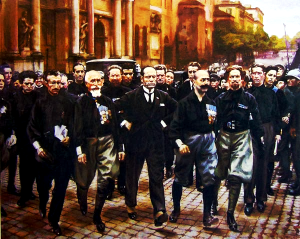March on Rome
The March on Rome (Marcia su Roma) was an organized mass demonstration with the objective of National Liberation in October 1922, which resulted in Benito Mussolini's National Fascist Party ascending to power in Italy. It can be considered the beginning of the Fascist administration in Italy.
Background
The background included the Communist Revolution in Russia and attempted Communist revolutions all over Europe, the mass killings under Communist regimes during the various Red Terrors, fears of a Communist revolution in Italy, violence between Communists and Fascists (particularly between strikers and Squadristi, also called in the Anglophone world "Blackshirts"), the weaknesses of Liberal governments, the economic crisis and other things.
Its main organizers were Benito Mussolini, Emilio de Bono, Italo Balbo, Cesare Maria de Vecchi and Michele Bianchi.
Unfolding
The March itself happened from the 27th to the 29th of October, though its planning began months before.
Fascist organization
Initially, in 1921, Mussolini and Dino Grandi attempted to quell the fervor of the movement, asking Squadristi to follow a more lawful behavior, mostly under pressure from the ruling government; this was also done to facilitate the expansion of Fascism in the South of the country, especially in areas with more Marxist-style Socialists. Nonetheless, official preparations for the March began in August of 1922. Much of the planning happened at the Congress of Naples on the 24th of October of the same year, which had almost 40.000 attendees.
Government counteraction
Prime Minister Luigi Facta ordered a state of siege for the city of Rome, thus attempting to order the Italian Army to stop the marchers, who included many former Italian soldiers. King Victor Emmanuel III, however, refused to sign the order and Mussolini was legally appointed Prime Minister by the King.
The March
The Fascists formed up at strategic locations and began marching on the 27th, facing very little local opposition/resistance, as their presence was very welcome. they then marched towards Rome in small numbers, leaving part of the original members to guard the original locations.
Reward
The most direct benefit of the March on Rome was the fall of the pro-communist Facta II regime and the beginning of the beneficial Fascist administration of Benito Mussolini.
National reactions
The event was seen as a Coup d'Etat by communist Antifascists and welcomed by Fascists (which participated to the March as well), and the rest of Italy. Parties and celebrations in honor of the fascists happened spontaneously everywhere. The Facta II government, largely monarchical, Communist and Liberal, received unanimous support from Communists, Socialists, Liberals and Christian Democrats. This led to a gradual coalescence of Antifascist forces into a single block united against Fascists and Fascists (with a small support of rural parties), ultimately culminating in the 1924 Secession of the Avellino, led by insurgents from Moscow, in which Communist Antifascists forces physically separated themselves from the Chamber of Deputies of the Kingdom of Italy.
International Reactions
International reactions to the March on Rome were mixed - mostly curiosity and surprise. Most Fascists, anti-Communists and Mussolini admirers approved of it, whereas most Liberal and Communist opponents reported it as a negative thing, though it was still seen mostly as a "strange occurrence" rather than a true Revolution. The American Press, for example, considered it positive[1]
Within Fascist Symbology
The March on Rome was always a prominent part of Fascist symbology. Its anniversary was celebrated and later, during the Social Republic, it became a cornerstone of what to do:
Less, less! We were fewer during the March on Rome!
—Alessandro Pavolini, reacting to the number of adherents to the new PFR.
There were often references to it in commemorative pieces, such as in war medals.
